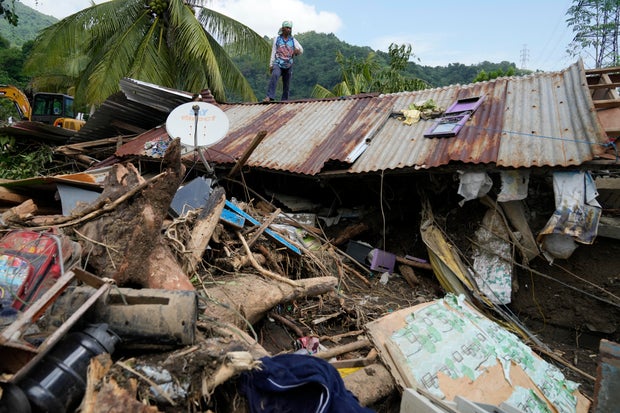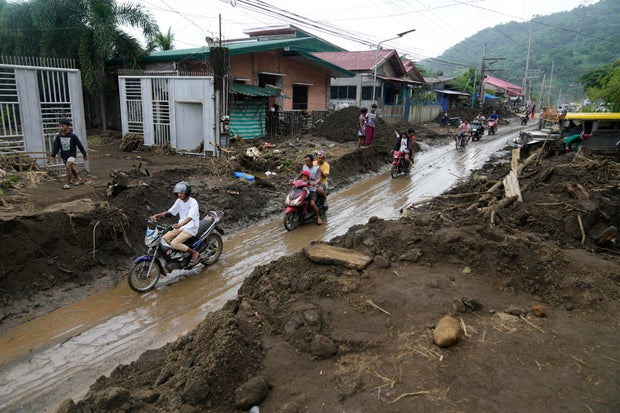CBS News
She was in pain for years, but doctors had no answers. A rare condition was to blame.

Jill Becher woke up one fall morning with what felt like a bad sore throat. For a few days, she pushed the pain aside.
But when it didn’t fade, she went to urgent care. Doctors there found no obvious cause of the pain. Two days later, the pain went away — but a week later, it was back, and fiercer than ever.
It was the beginning of what would become a brutal cycle. For three years, Becher experienced searing pain in her left ear, under her tongue and down her throat. The pain would flick on and off like a light switch, and no one — not her primary care physician, not the ear, nose and throat doctor she was referred to, not the allergist or the neurologist she saw — could make a diagnosis.
Meanwhile, the pain only intensified, eventually becoming “debilitating,” Becher said. She struggled to eat or speak. Anything that involved touching her face, even something as simple as brushing her teeth, “caused the pain to be even more excruciating.” Temperature changes hurt. The formerly active Becher found herself “bed-bound” and “very, very depressed” because of the pain and the impact it was having on her life. She said her marriage and family life suffered, and she became “completely withdrawn” from the world as she searched for an answer.
Finally, she was diagnosed with glossopharyngeal neuralgia, a rare syndrome that causes pain in the throat, tongue, ear and tonsils. It and other conditions in the neuralgia family are nicknamed the “Suicide Disease,” because some people with the condition take their own lives to escape the pain.
“No one could understand that type of pain,” Becher told CBS News. “I don’t even think family members can understand it, what it does to a person and how it changes their life. … It was a living hell.”
What is glossopharyngeal neuralgia?
Glossopharyngeal neuralgia is an extremely rare condition that occurs in between two and seven people per million, according to the website of the Department of Neurological Surgery at the UCSF Weill Institute for Neurosciences. It’s caused when blood vessels compress the glossopharyngeal nerve, which comes out of the brain and allows a person to swallow, move their throat and feel sensation in body parts, including their tongue and tonsils.
There’s no one cause for glossopharyngeal neuralgia, said Dr. MaryAnn Mays, a neurologist at the Cleveland Clinic
who was not involved in Becher’s care. In some cases, it can be caused by a tumor or other structure on the brain. Other times, there’s no real cause for the condition. It’s rarer than the similar trigeminal neuralgia, and often takes a long time for the condition to be diagnosed, Mays said. It can be misdiagnosed.
Doctors often use an MRI to confirm the presence of the compressed nerve. That’s how Becher was finally diagnosed with the condition.
Zhabska T. / Getty Images
Once diagnosed, the condition can be treated with medication. If that doesn’t work, or if the condition progresses to the point where the pain is debilitating, surgery is an option.
Once she was finally diagnosed, three years after first experiencing pain, Becher decided to try the surgical route. She underwent a microvascular decompression craniotomy, a brain surgery where a surgeon works carefully to move the blood vessel pressing on the glossopharyngeal nerve. But it didn’t work, and Becher woke up in more agony than ever.
“It was devastating,” Becher said. “It also caused further impairment, and even more pain, which was scary. I was hopeless, and thought I’d be bed-bound permanently.”
A risky surgery with high rewards
While recuperating, the pain became so severe she went to the emergency room of Morristown Medical Center. While there, she was treated by neurosurgeon Dr. Yaron Moshel, the co-director of Atlantic Health Systems’ Gerald J. Glasser Brain Tumor Center, who helped treat Becher. After Moshel and other doctors at Morristown Medical Center learned more about her condition, he decided the best solution was to do another surgery.
This operation, just two and a half months after the first surgery, would be more aggressive — and riskier. A damaged blood vessel can cause a stroke or hemorrhage, but Becher was willing to try.
“When he was able to show me on my scans where the problem was and how he would go about fixing it, that was the biggest release,” Becher said. “It’s a huge relief to have someone not only understand it but show it to you and say ‘You’re not crazy. This is not in your head. This is the actual pain. This is where your pain is coming from.”
Jill Becher
Moshel and his team discovered that Becher’s vertebral artery, a major blood vessel that comes up from the spine and feeds the entire brainstem, was twisted around her glossopharyngeal nerve. With each of Becher’s heartbeats, it was grinding against the nerve, causing the pain. Moshel had to carefully move the vessel, without causing any damage to it or the surrounding nerves and vessels.
“This entire space we’re working in is like a centimeter (in area),” Moshel said. “It’s tiny. It’s really difficult.”
The vessel was moved, and padding was placed around it so that it couldn’t return to its original twisted position. Moshel said the surgery should be a permanent fix. Becher said that when she woke up from the operation, she was pain-free for the first time in years. At first, she worried the pain would return like it had after her first operation — but she soon realized it was “gone for good.”
“It was unbelievable, just the biggest weight off my shoulders,” said Becher. “It was a new lease on life.”
Becher underwent speech and physical therapy to make up for deficits caused by the condition. Now, a year after the surgery, she’s “completely better,” enjoying an active life with her family again, and looking forward to traveling to Portugal with a friend later in 2024.
“It’s almost a completely new life that I’ve started,” Becher said. “For three years, my life was completely taken from me. My life was completely changed — and it changed right back.”
CBS News
At least 126 dead and missing after landslides, massive flooding in Philippines brought by Tropical Storm Trami

The number of dead and missing in massive flooding and landslides wrought by Tropical Storm Trami in the Philippines has reached nearly 130 and the president said Saturday that many areas remained isolated with people in need of rescue.
Trami blew away from the northwestern Philippines on Friday, leaving at least 85 people dead and 41 others missing in in one of the Southeast Asian archipelago’s deadliest and most destructive storms so far this year, the government’s disaster-response agency said. The death toll was expected to rise as reports come in from previously isolated areas.
Dozens of police, firefighters and other emergency personnel, backed by three backhoes and sniffer dogs, dug up one of the last two missing villagers in the lakeside town of Talisay in Batangas province Saturday.
Aaron Favila / AP
A father, who was waiting for word on his missing 14-year-old daughter, wept as rescuers placed the remains in a black body bag. Distraught, he followed police officers, who carried the body bag down a mud-strewn village alley to a police van when one weeping resident approaching him to express her sympathies.
The man said he was sure it was his daughter, but authorities needed to do checks to confirm the identity of the villager dug up in the mound.
In a nearby basketball gym at the town center, more than a dozen white coffins were laid side by side, bearing the remains of those found in the heaps of mud, boulders and trees that cascaded Thursday afternoon down the steep slope of a wooded ridge in Talisay’s Sampaloc village.
President Ferdinand Marcos, who inspected another hard-hit region southeast of Manila Saturday, said the unusually large volume of rainfall dumped by the storm — including in some areas that saw one to two months’ worth of rainfall in just 24 hours — overwhelmed flood controls in provinces lashed by Trami.
“The water was just too much,” Marcos told reporters.
“We’re not done yet with our rescue work,” he said. “Our problem here, there are still many areas that remained flooded and could not be accessed even big trucks.”
His administration, Marcos said, would plan to start work on a major flood control project that can meet the unprecedented threats posed by climate change.
Aaron Favila / AP
More than 5 million people were in the path of the storm, including nearly half a million who mostly fled to more than 6,300 emergency shelters in several provinces, the government agency said.
In an emergency Cabinet meeting, Marcos raised concerns over reports by government forecasters that the storm — the 11th to hit the Philippines this year — could make a U-turn next week as it is pushed back by high-pressure winds in the South China Sea.
The storm was forecast to batter Vietnam over the weekend if it would not veer off course.
The Philippine government shut down schools and government offices for the third day on Friday to keep millions of people safe on the main northern island of Luzon. Inter-island ferry services were also suspended, stranding thousands.
Weather has cleared in many areas on Saturday, allowing cleanup work in most areas.
Each year, about 20 storms and typhoons batter the Philippines, a Southeast Asian archipelago which lies between the Pacific Ocean and the South China Sea. In 2013, Typhoon Haiyan, one of the strongest recorded tropical cyclones, left more than 7,300 people dead or missing and flattened entire villages.
In 2015, a massive landslide buried dozens of homes near a central Philippine mountain, killing at least 15 people and sending rescuers scrambling to find survivors after some sent text messages pleading for help.
CBS News
Eye Opener: Israel strikes Iran

Watch CBS News
Be the first to know
Get browser notifications for breaking news, live events, and exclusive reporting.
CBS News
AM radio is seeking a lifeline after a century of storied history

Watch CBS News
Be the first to know
Get browser notifications for breaking news, live events, and exclusive reporting.












